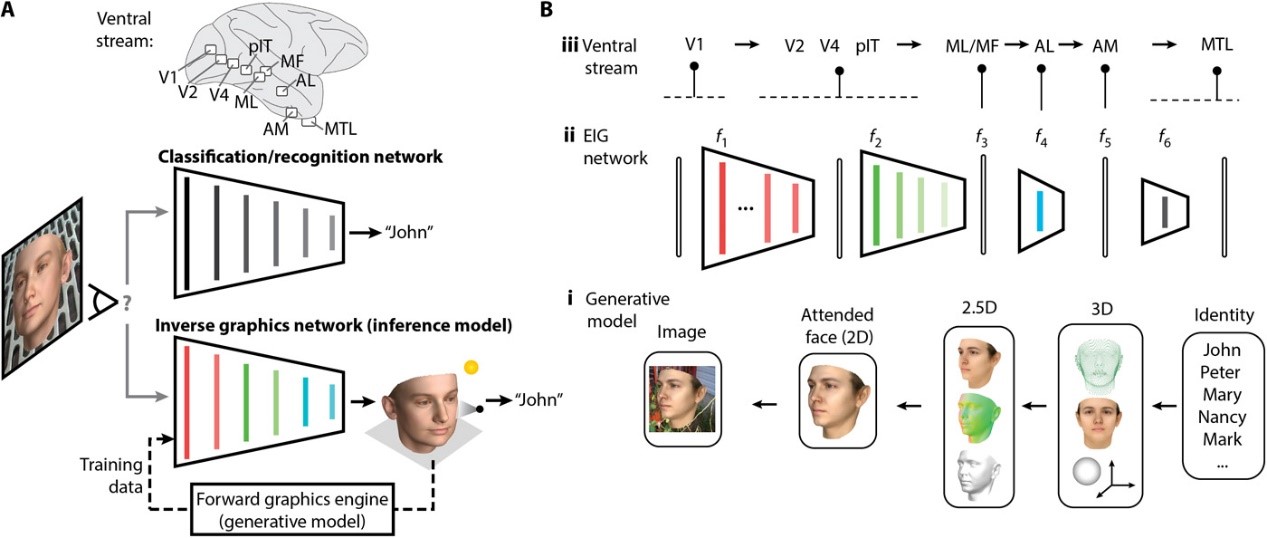热点文献带您关注AI与人脸识别——图书馆前沿文献专题推荐服务(49)
2021-11-01

在上一期AI文献推荐中,我们为您推荐了人工智能在生物学领域的热点文献,包括提高RNA结构预测能力的深度学习方法、应用深度学习设计高度多样化的AAV衣壳蛋白变体、利用基于深度学习的精确估计指导改进蛋白质结构、利用递归神经网络寻找基因网络拓扑等方面的文献。
本期我们为您选取了4篇文献,介绍AI在人脸识别研究方面的热点文献,包括基于深度神经网络的人脸识别高效逆向图形模型,用于高性能人脸检测的细化神经网络,一种新的基于SensitiveNets的对抗性学习策略的隐私保护神经网络特征表示方法,用于近红外可见光人脸识别的大规模多姿态高质量数据库等文献,推送给相关领域的科研人员。
文献一 基于深度神经网络的人脸识别高效逆向图形模型
Efficient inverse graphics in biological face processing
Yildirim, Ilker., etc.
SCIENCE ADVANCES, 2020, 6(10)
Vision not only detects and recognizes objects, but performs rich inferences about the underlying scene structure that causes the patterns of light we see. Inverting generative models, or “analysis-by-synthesis”, presents a possible solution, but its mechanistic implementations have typically been too slow for online perception, and their mapping to neural circuits remains unclear. Here we present a neurally plausible efficient inverse graphics model and test it in the domain of face recognition. The model is based on a deep neural network that learns to invert a three-dimensional face graphics program in a single fast feedforward pass. It explains human behavior qualitatively and quantitatively, including the classic “hollow face” illusion, and it maps directly onto a specialized face-processing circuit in the primate brain. The model fits both behavioral and neural data better than state-of-the-art computer vision models, and suggests an interpretable reverse-engineering account of how the brain transforms images into percepts.
阅读原文 https://www.science.org/doi/10.1126/sciadv.aax5979

Overview of the modeling framework and EIG model
文献二 用于高性能人脸检测的细化神经网络
RefineFace: Refinement Neural Network for High Performance Face Detection
Zhang, Shifeng, etc.
IEEE TRANSACTIONS ON PATTERN ANALYSIS AND MACHINE INTELLIGENCE, 2021, 43(11): 4008-4020
Face detection has achieved significant progress in recent years. However, high performance face detection still remains a very challenging problem, especially when there exists many tiny faces. In this paper, we present a single-shot refinement face detector namely RefineFace to achieve high performance. Specifically, it consists of five modules: selective two-step regression (STR), selective two-step classification (STC), scale-aware margin loss (SML), feature supervision module (FSM) and receptive field enhancement (RFE). To enhance the regression ability for high location accuracy, STR coarsely adjusts locations and sizes of anchors from high level detection layers to provide better initialization for subsequent regressor. To improve the classification ability for high recall efficiency, STC first filters out most simple negatives from low level detection layers to reduce search space for subsequent classifier, then SML is applied to better distinguish faces from background at various scales and FSM is introduced to let the backbone learn more discriminative features for classification. Besides, RFE is presented to provide more diverse receptive field to better capture faces in some extreme poses. Extensive experiments conducted on WIDER FACE, AFW, PASCAL Face, FDDB, MAFA demonstrate that our method achieves state-of-the-art results and runs at 37.3 FPS with ResNet-18 for VGA-resolution images.
阅读原文 https://ieeexplore.ieee.org/document/9099607

Structure of RefineFace
文献三 一种隐私保护神经网络特征表示方法
SensitiveNets: Learning Agnostic Representations with Application to Face Images
Morales, Aythami, etc.
IEEE TRANSACTIONS ON PATTERN ANALYSIS AND MACHINE INTELLIGENCE, 2021, 43(6): 2158-2164
This work proposes a novel privacy-preserving neural network feature representation to suppress the sensitive information of a learned space while maintaining the utility of the data. The new international regulation for personal data protection forces data controllers to guarantee privacy and avoid discriminative hazards while managing sensitive data of users. In our approach, privacy and discrimination are related to each other. Instead of existing approaches aimed directly at fairness improvement, the proposed feature representation enforces the privacy of selected attributes. This way fairness is not the objective, but the result of a privacy-preserving learning method. This approach guarantees that sensitive information cannot be exploited by any agent who process the output of the model, ensuring both privacy and equality of opportunity. Our method is based on an adversarial regularizer that introduces a sensitive information removal function in the learning objective. The method is evaluated on three different primary tasks (identity, attractiveness, and smiling) and three publicly available benchmarks. In addition, we present a new face annotation dataset with balanced distribution between genders and ethnic origins. The experiments demonstrate that it is possible to improve the privacy and equality of opportunity while retaining competitive performance independently of the task.
阅读原文 https://ieeexplore.ieee.org/document/9163294

The Framework, including including domain adaptation from a pre-trained face representation
x to multiple tasks (Verification, Gender, and Ethnicity classification)
文献四 用于近红外可见光人脸识别的大规模多姿态高质量数据库
LAMP-HQ: A Large-Scale Multi-Pose High-Quality Database for NIR-VIS Face Recognition
Yu, Aijing, etc.
INTERNATIONAL JOURNAL OF COMPUTER VISION, 2021, 129(5): 1467-1483
Near-infrared-visible (NIR-VIS) heterogeneous face recognition matches NIR to corresponding VIS face images. However, due to the sensing gap, NIR images often lose some identity information so that the NIR-VIS recognition issue is more difficult than conventional VIS face recognition. Recently, NIR-VIS heterogeneous face recognition has attracted considerable attention in the computer vision community because of its convenience and adaptability in practical applications. Various deep learning-based methods have been proposed and substantially increased the recognition performance, but the lack of NIR-VIS training samples leads to the difficulty of the model training process. In this paper, we propose a new Large-Scale Multi-Pose High-Quality NIR-VIS database ‘LAMP−HQ’ containing 56,788 NIR and 16,828 VIS images of 573 subjects with large diversities in pose, illumination, attribute, scene and accessory. We furnish a benchmark along with the protocol for NIR-VIS face recognition via generation on LAMP-HQ, including Pixel2-Pixel, CycleGAN, ADFL, PCFH, and PACH. Furthermore, we propose a novel exemplar-based variational spectral attention network to produce high-fidelity VIS images from NIR data. A spectral conditional attention module is introduced to reduce the domain gap between NIR and VIS data and then improve the performance of NIR-VIS heterogeneous face recognition on various databases including the LAMP-HQ.
阅读原文 https://link.springer.com/article/10.1007/s11263-021-01432-4
往期精彩推荐
前沿论文带您解读5G应用领域 ——图书馆前沿文献专题推荐服务(2)
热点论文解读AI应用领域 ——图书馆前沿文献专题推荐服务(3)
热点论文带您探究5G和未来通信——图书馆前沿文献专题推荐服务 (4)
前沿文献带您解读自然语言处理技术 ——图书馆前沿文献专题推荐服务(5)
热点论文带您探究5G和未来通信材料技术领域 ——图书馆前沿文献专题推荐服务(6)
热点论文解读AI应用领域 ——图书馆前沿文献专题推荐服务(3)
热点论文带您探究5G和未来通信——图书馆前沿文献专题推荐服务 (4)
前沿文献带您解读自然语言处理技术 ——图书馆前沿文献专题推荐服务(5)
热点论文带您探究5G和未来通信材料技术领域 ——图书馆前沿文献专题推荐服务(6)
热点文献带您关注AI情感分类技术 ——图书馆前沿文献专题推荐服务(7)
热点论文带您探究6G的无限可能——图书馆前沿文献专题推荐服务(8)
热点文献带您关注AI文本摘要自动生成 ——图书馆前沿文献专题推荐服务(9)
热点论文:5G/6G引领社会新进步——图书馆前沿文献专题推荐服务(10)
热点文献带您关注AI机器翻译 ——图书馆前沿文献专题推荐服务(11)
热点论文与您探讨5G/6G网络技术新进展——图书馆前沿文献专题推荐服务(12)
热点文献带您关注AI计算机视觉 ——图书馆前沿文献专题推荐服务(13)
热点论文与带您领略5G/6G的硬科技与新思路 ——图书馆前沿文献专题推荐服务(14)
热点文献带您关注AI计算机视觉 ——图书馆前沿文献专题推荐服务(15)
热点论文带您领略5G/6G的最新技术动向 ——图书馆前沿文献专题推荐服务(18)
热点文献带您关注图神经网络——图书馆前沿文献专题推荐服务(19)
热点论文与带您领略5G/6G材料技术的最新发展——图书馆前沿文献专题推荐服务(20)
热点文献带您关注模式识别——图书馆前沿文献专题推荐服务(21)
热点论文与带您领略6G网络技术的最新发展趋势 ——图书馆前沿文献专题推荐服务(22)
热点文献带您关注机器学习与量子物理 ——图书馆前沿文献专题推荐服务(23)
热点论文与带您领略5G/6G通信器件材料的最新进展 ——图书馆前沿文献专题推荐服务(24)
热点文献带您关注AI自动驾驶——图书馆前沿文献专题推荐服务(25)
热点论文与带您领略5G/6G网络安全和技术的最新进展——图书馆前沿文献专题推荐服务(26)
热点文献带您关注AI神经网络与忆阻器——图书馆前沿文献专题推荐服务(27)
热点论文与带您领略5G/6G电子器件和太赫兹方面的最新进展——图书馆前沿文献专题推荐服务(28)
热点文献带您关注AI与机器人——图书馆前沿文献专题推荐服务(29)
热点论文与带您领略5G/6G热点技术的最新进展——图书馆前沿文献专题推荐服务(30)
热点文献带您关注AI与触觉传感技术——图书馆前沿文献专题推荐服务(31)
热点论文与带您领略5G/6G热点技术的最新进展——图书馆前沿文献专题推荐服务(32)
热点文献带您关注AI深度学习与计算机视觉——图书馆前沿文献专题推荐服务(33)
热点论文与带您领略未来通信的热点技术及最新进展——图书馆前沿文献专题推荐服务(34)
热点文献带您关注AI强化学习——图书馆前沿文献专题推荐服务(35)
热点论文与带您领略5G/6G基础研究的最新进展——图书馆前沿文献专题推荐服务(36)
热点文献带您关注AI与边缘计算——图书馆前沿文献专题推荐服务(37)
热点论文与带您领略5G/6G领域热点研究的最新进展——图书馆前沿文献专题推荐服务(38)
热点文献带您关注AI技术的最新进展——图书馆前沿文献专题推荐服务(39)
热点论文与带您领略5G相关领域研究的最新进展——图书馆前沿文献专题推荐服务(40)
热点文献带您关注AI视觉跟踪——图书馆前沿文献专题推荐服务(41)
热点论文带您领略未来通信在海空领域研究的最新进展——图书馆前沿文献专题推荐服务(42)
热点文献带您关注AI与医学研究——图书馆前沿文献专题推荐服务(43)
热点论文带您领略未来通信在材料领域研究的最新进展——图书馆前沿文献专题推荐服务(44)
热点文献带您关注AI与医学图像——图书馆前沿文献专题推荐服务(45)
热点论文带您领略未来通信在光电材料及信息编码领域的最新进展——图书馆前沿文献专题推荐服务(46)
热点文献带您关注AI与生物学——图书馆前沿文献专题推荐服务(47)
热点论文带您领略未来通信在新材料技术领域的最新进展——图书馆前沿文献专题推荐服务(48)